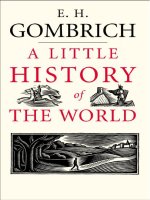university of california press a critical history of early rome from prehistory to the first punic war feb 2005
Bạn đang xem bản rút gọn của tài liệu. Xem và tải ngay bản đầy đủ của tài liệu tại đây (2.38 MB, 421 trang )
The publisher gratefully acknowledges the generous contribution
to this book provided by the Classical Literature Endowment Fund
of the University of California Press Associates, which is supported
by a major gift from Joan Palevsky.
A Critical History of Early Rome
A Critical History
of Early Rome
From Prehistory to the First Punic War
Gary Forsythe
UNIVERSITY OF CALIFORNIA PRESS
Berkeley
Los Angeles
London
University of California Press
Berkeley and Los Angeles, California
University of California Press, Ltd.
London, England
©2005 by the Regents of the University of California
Library of Congress Cataloging-in-Publication Data
Forsythe, Gary.
A critical history of early Rome: from prehistory to the first
Punic War / Gary Forsythe
p. cm.
Includes bibliographical references and index.
ISBN 0–520–22651–8 (cloth : alk. paper)
1. Rome—History— To 510 B.C. 2. Rome—History—
Republic, 510–265 B.C. I. Title.
DG209.F735 2005
937—dc22
2004008505
Manufactured in the United States of America
13 12 11 10 09 08 07 06
10 9 8 7 6 5 4 3 2 1
05
Printed on Ecobook 50 containing a minimum 50% post-consumer
waste, processed chlorine free. The balance contains virgin pulp,
including 25% Forest Stewardship Council Certified for no old
growth tree cutting, processed either TCF or ECF. The sheet is
acid-free and meets the minimum requirements of ANSI/NISO
Z39.48–1992 (R 1997) (Permanence of Paper).
contents
list of tables and illustrations
acknowledgments / xi
dedication / xiii
abbreviations / xv
foreword / 1
/
ix
1. Italy in Prehistory
/ 7
The Land and its Linguistic Diversity / 7
Modern Archaeology and Prehistory / 12
Prehistoric Italy / 14
The Ice Man / 18
The Bronze and Iron Ages / 20
Ancient Languages and Modern Archaeology /
26
2. Archaic Italy c. 800–500 B.C.
/ 28
Phoenicians in the West / 29
Greek Colonization in the West / 31
The Formation of Etruscan Civilization / 36
Phoenicians, Greeks, and Etruscans / 41
Growth and Decline of Etruscan Civilization /
The Alphabet / 51
The Archaeology of Early Latium / 53
46
3. The Ancient Sources for Early Roman History
The Annalistic Tradition / 60
The Antiquarian Tradition / 64
Livy and Dionysius of Halicarnassus / 66
Cicero and Diodorus Siculus / 68
Ancient Documentary Sources / 69
Roman Oral Tradition and Greek Myth / 74
/
59
vi
contents
4. Rome During the Regal Period
/
The Nature of the Evidence / 78
The Site of Rome / 80
The Archaeology of Early Rome / 82
The Ancient Literary Tradition / 93
Archaic Roman Institutions / 108
Rome’s Growth and Expanding Horizons
78
/
115
5. Archaic Roman Religion
/ 125
Some Important Roman Divinities / 126
The Official Religious Calendar / 129
The Religious Priesthoods / 135
Roman Religious Practices and Ideology /
143
6. The Beginning of the Roman Republic
/
How Did The Monarchy End? / 147
The Nature and Origin of the Consulship / 150
The Early Consular Fasti / 155
Patricians and Plebeians / 157
Senators, Patricians, and Priests / 167
The Plebeian Tribunate / 170
The Tribal and Other Assemblies / 177
Rome and the Latins / 183
Sp. Cassius, the Fabii, and the Cremera / 192
Clan Warfare and the Lapis Satricanus / 198
147
7. Rome of the Twelve Tables
/ 201
The Trial of K. Quinctius / 204
Appius Herdonius and Quinctius Cincinnatus / 205
Facts and Fictions of the Plebeian Tribunate / 207
The Decemviral Legislation / 209
Jurisdiction in Early Roman Law / 211
Litigation and Orality in Early Roman Law / 213
Society and Economy / 216
The Second Board of Decemvirs / 222
The Prohibition of Intermarriage / 225
The Second Secession and the Valerian Horatian Laws /
230
8. Evolution and Growth of the Roman State, 444–367 B.C.
The Military Tribunes with Consular Power / 234
The Sedition of Sp. Maelius / 239
The War Against Fidenae / 241
The War Against Veii / 246
The Gallic Catastrophe and Its Aftermath / 251
The Sedition of M. Manlius Capitolinus / 259
The Licinian Sextian Laws / 262
9. Rome’s Rise to Dominance, 366–300 B.C.
The Emergence of the Roman Nobility /
Tibur, Gauls, Greeks, and Carthage /
268
277
/
268
/
234
contents
The Samnites and the First Samnite War / 281
The Latin War and its Consequences / 289
The Second Samnite War / 292
The Philinus Treaty / 311
Other Significant Changes in the Roman State /
Roman Factional Politics / 321
312
10. Rome’s Conquest and Unification of Italy, 299–264 B.C.
The Third Samnite War / 324
Early Roman Coinage / 336
Military Ethos and Aristocratic Family Tradition /
Domestic and Foreign Affairs during the 280s B.C. /
The Pyrrhic War / 349
The Roman Organization of Italy / 358
Some Final Assessments / 366
appendix: early roman chronology
works cited / 371
index / 391
/
340
344
369
/
324
vii
tables and illustrations
TABLES
1. Outline of the later centuriate organization
/
2. Total manpower for the regions of Italy 225 B.C.
112
/
365
MAPS
1. Physical map of Italy
/
8
2. Linguistic groups of Italy c. 350 B.C.
3. Map of prehistoric sites
/
4. The ancient Mediterranean
/
11
17
/
30
5. Greek colonization in Sicily and Southern Italy
6. Etruria
7. Rome
8. Latium
/
/
/
33
40
81
/
185
9. The Samnite tribes and neighboring ethnic groups
10. Roman territory and colonization c. 250 B.C.
/
/
282
/
26
364
FIGURES
1. Biconical Villanovan ash-urn covered with a helmet
2. Hut-shaped cremation urns
/
55
ix
x
tables and illustrations
3. Scene from the Fran˛ ois Tomb at Vulci depicting Macstrna
c
and Caile Vipinas / 104
4. Etruscan god of the underworld wearing a wolf ’s head
5. Bronze model of a sheep’s liver
/
/
134
140
6. Chronological distribution of new clans attaining high office
7. Terracotta cult statue of Apollo from Veii
/
247
8. Horseshoe-shaped sandstone funerary stela from Felsina
9. Ficoroni Cista from Praeneste
/
317
10. The Romano-Campanian didrachms
/
337
/
/
252
165
acknowledgments
The many debts of gratitude incurred in the course of researching and
writing this book are too numerous to be easily enumerated, but common
decency requires that the author at least make an attempt to acknowledge
the most obvious and important ones. Thanks are due to Kurt A. Raaflaub,
A. John Graham, Martin Ostwald, Michael Alexander, Brent Vine, Mark
Toher, Richard Mitchell, and Ernst Badian for their comments, criticisms,
and suggestions. Thanks are due also to Kate Toll, the copy editrix, whose
intelligent and well-informed editing of the text has made it more readable.
A great debt is owed to Scott Pathel for his computer expertise employed in
the preparation of the maps and other illustrations used in this book.
Thanks are due to the people at the reference desk in the Westchester
Public Library in Chesterton, Indiana for their assistance in obtaining many
books and articles through inter-library loan.
Although the author was occupied with the research and writing of this
book from the summer of 1997 to the spring of 1999, in a certain sense this
book has been in the making for very many years; and as a direct consequence of the author’s blindness, he is greatly indebted to many friends
and fellow college students, who over the years have given him many hours
of their time in order to read books and articles to him. Out of this very
long list of devoted volunteer readers the author wishes to mention by name
the following persons whose voices recorded on tape have been the author’s
constant companions as he wrote the present volume: Lloyd Daly, Peter
Denault, Becky Harrison, Sarah Kimball, Scott Rusch, Nell Wright, Sina
Dubovoj, and especially Terry Trotter (who now teaches mathematics in
San Salvador), Peg Decker (who died at about the time the work on this
book was begun), Kitty Reip and her sister Kandi Kaliher (the latter of
whom died of cancer in November of 1994). Special thanks are also due to
xi
xii
acknowledgments
the author’s dear college friend of many years ago, Bryan McMurray, and
his gracious wife, Joanna, for allowing the author to enjoy the hospitality of
their home in Champaign, Illinois, while he made use of the University of
Illinois’s vast library resources. Unfortunately, due to her death the author’s
wife, Dorothy Alice Forsythe, was not able to assist in the final proofreading
of the copyedited text. This task was carried out by a very dear friend,
Marnie Veghte. Yet the greatest debt of gratitude by far is owed to the
author’s wife, Dorothy, for her countless hours of assistance in every conceivable capacity. Attempting to record the innumerable ways in which this
book is indebted to this extraordinary woman would involve an entire chapter
of its own.
Toward the end of the five-year period during which this work
has gone from manuscript to published book, my most lovely,
loving, and beloved wife Dorothy Alice died of cancer
(March 8, 2003). Over the past thirty-one years she has
assisted me in countless ways, has been the light of my life,
and has been the best love-mate, life-mate, and help-mate
a person could ever hope to have.
To thee, my dearest love, the most perfect person whom I have
known, I dedicate this book. You were my first love, my one and
only love, and the great passion of my life. Words cannot express
how much I love and miss you, and how grateful I am to you for
having blessed and graced my life with your supreme goodness,
incomparable sweetness, and infinite love.
As your name suggests, you have been and continue to be a truly
divine gift to all of us who knew and loved you.
Dedicated to Dorothy Alice Forsythe on July 29, 2003,
my darling’s seventy-fifth birthday.
abbreviations
ad Att.
ad Q. Fr.
Akten 1981.
Aug. Civ. Dei
Caes. Bell. Gall.
CAH
Cat.
CIL.
Cic. Amic.
Cic. De Re Pub.
Cic. Phil.
Cic. Tusc. Disp.
CLP
CSE
Diod.
Dion. Hal.
Frontinus Strat.
Gell.
Hdt.
ILLRP
ILS
Cicero, Letters to Atticus
Cicero, Letters to His Brother Quintus
Akten des Kolloquiums zum Thema die Göttin von
Pyrgi: Archäologische, Linguistische und
Religionsgeschichtliche Aspekte (Tübingen, 16–7
Januar 1979). 1981. Instituto di Studi Etruschi
ed Italici, Florence. Appian Bell. Civ. Appian,
Bella Civilia
Augustine, City of God
Caesar, Bellum Gallicum
Cambridge Ancient History
Cicero, Against Catiline
Corpus Inscriptionum Latinarum
Cicero, De Amicitia
Cicero, De Re Publica
Cicero, Philippics
Cicero, Tusculan Disputations
Civiltà del Lazio Primitivo, Exhibition Catalogue
Corpus Speculorum Etruscorum
Diodorus Siculus, The Library
Dionysius of Halicarnassus, Roman Antiquities
Frontinus, Stratagems
Aulus Gellius, Attic Nights
Herodotus, The Histories
Inscriptiones Latinae LiberaeRei Publicae
Inscriptiones Latinae Selectae. H. Dessau, ed.
1892–1916.
xv
xvi
abbreviations
Pliny NH
Plutarch QR
Plutarch Rom.
Polyb.
Sallust Bell. Iug.
Seneca Controv.
Serv. ad Aen.
Serv. ad Ecl.
SIG
Suet. Tib.
Suet. Vitellius
Tacitus Ann. and Hist.
Theophrastus Hist. Plant.
Thuc.
Ulpian Tit.
Val. Max.
Varro Ling. Lat.
Vell. Pat.
Vir. Ill.
Pliny the Elder, Natural History
Plutarch, Roman Questions
Plutarch, Life of Romulus
Polybius, Histories
Sallust, Bellum Iugurthinum
Seneca the Elder, Controversiae
Servius, Commentary on the Aeneid of Vergil
Servius, Commentary on Vergil’s Eclogues
Sylloge Inscriptionum Graecarum
Suetonius, Life of Tiberius
Suetonius, Life of Vitellius
Tacitus, Annales and Histories
Theophrastus, Historia Plantarum
Thucydides, The Peloponnesian War
Ulpian, Tituli
Valerius Maximus, Memorable Deeds and Sayings
Varro, De Lingua Latina
Velleius Paterculus, History
De Viris Illustribus
foreword
This book narrates the early history of Rome, one of the most successful
imperial powers of world history. Although the story told here ends with
the subjugation of Italy and thus does not treat the great wars of overseas
conquest, during Rome’s advancement from a small town on the Tiber
River to the ruling power of the Italian peninsula the Romans in large measure developed the social, political, and military institutions that formed
the foundations of their later imperial greatness.
Throughout human history there have been many nations or peoples
who have greatly extended their power or territory by conquest, but only a
small number of such states have been able to retain their conquests beyond
three or four generations. Conquest requires little more than the successful
application of military might, whereas the lasting success of an imperial
power depends upon its ability to adapt military, political, social, economic,
cultural, and religious institutions to accommodate change over time and
to serve more than the narrow self-interest of a ruling oligarchy. Unlike
many ancient Greek city-states, such as Athens and Sparta, which excluded
foreigners and subjects from political participation, Rome from its beginning did not hesitate to incorporate conquered peoples into its social and
political system. Allies and subjects who adopted Roman ways were eventually granted Roman citizenship and became fully participating members in
Roman society.
Rome’s early development occurred in a multi-cultural environment,
and its institutions and practices were significantly affected by such diversity. Since the site of Rome, situated twelve miles inland from the sea on the
Tiber River that separated Latium from Etruria, commanded a convenient
river crossing and lay on a land route from the Apennines to the sea, geography brought together three distinct peoples at the site of early Rome:
1
2
foreword
Latins, Etruscans, and Sabines. Though Latin in speech and culture, the
Roman population must have been somewhat diverse from earliest times, a
circumstance which doubtless goes far in explaining the openness of
Roman society in historical times. Given present-day interests in issues of
ethnicity, multi-culturalism, and cultural diversity, Rome’s successful unification of the diverse peoples of early Italy is a subject worthy of careful and
serious study.
This volume is aimed at three rather different constituencies: the general educated reader interested in having a general but sophisticated
account of early Roman history, the college undergraduate enrolled in
survey or more advanced courses on ancient Rome, and the more specialized graduate student and professional scholar of classical studies and
ancient history. Attempting to satisfy three such divergent groups is likely to
be overly ambitious; and although the author has tried to keep them constantly in mind, some portions of the narrative will inevitably serve one
group better than the other two. On the one hand, in order to produce a
coherent narrative, much of the book necessarily sets forth many issues on
which there is substantial agreement among modern scholars. This will best
serve the needs of the general educated reader and college undergraduate.
On the other hand, however, the study is much more than a mere general
survey or statement of current orthodoxy. It contains many original interpretations by the author and bears clear signs of his particular interests,
which are intended to engage the more specialized reader and instructor. The
book will be best understood and appreciated when read concurrently with
Livy’s first ten books, the Roman Antiquities of Dionysius of Halicarnassus, or
Plutarch’s biographies of Romulus, Numa, Publicola, Coriolanus, Camillus,
and Pyrrhus. In fact, the book’s organization is patterned to some degree
after the arrangement of Livy’s first ten books, which are our single most
important source on early Rome. The first three chapters serve as an introduction to the subject as a whole by treating the prehistoric, cultural-historical,
and historiographical background. Chapter 4 corresponds to Livy’s first
book in treating the period of the early kings; and following the excursus
on early Roman religion in chapter 5, chapters 6 and 7 correspond to Livy’s
second and third books. Chapter 8 covers the same material found in Livy
Books IV–VI, and chapter 9 is parallel to Livy Books VII–IX.
Modern scholarship on early Roman history in some ways resembles that
of the Homeric poems and their historicity. Differences of opinion and
interpretation largely hinge on individual scholars’ divergent assessments
of the relative historical value or worthlessness of the data. These problems
of evaluating ancient source material are complicated by the fact that both
Homer and Livy were highly skilled story tellers. They constructed such
vivid and compelling narratives of personalities and events that the modern
scholar, interested in basic questions of historicity, may often find it difficult
foreword
3
to suspend belief and thereby be seduced by their verisimilitude. As a result,
both modern Homeric scholarship and the study of early Roman history
have been characterized by wide divergences of opinion, which have tended
to run in cycles from one generation to the next (see Heurgon 1973,
244–50). Indeed, early Roman history can be regarded as a classic illustration of the old adage, “there are as many opinions as there are people (quot
homines tot sententiae).” It is inevitable, therefore, that many other scholars
will disagree sharply either with the basic approach taken or with various
individual interpretations set out in this book.
As indicated by the title, the overall approach adopted throughout this
volume is rather critical toward the general reliability of the surviving
ancient sources on early Roman history. Agreeing with M.I. Finley’s famous
dictum that “the ancients’ ability to invent and their capacity to believe are
persistently underestimated,” the author regards a critical approach as
entirely justified and necessary. Archaeological finds have been useful in
tracing Rome’s overall development during the pre-republican period, but
Roman history for the fifth and first half of the fourth centuries B.C. remains
extremely problematic due to the nature of the surviving ancient historical
tradition. Then from the middle of the fourth century onwards this tradition gradually becomes more reliable as the events described approach the
period of Rome’s earliest historians.
It must always be kept in mind that the ancient Romans did not begin to
write their own history until c. 200 B.C. By that time a well formulated tradition about the early kings and the early republic was already firmly established, and this historical tradition continued to be reshaped during the
next 170 years until it was given final literary expression in the works of Livy
and Dionysius of Halicarnassus. Herodotus’s description of the Persian
Wars may offer us an instructive historiographical parallel. Although the
Greek historian conducted his research and composed his historical
account only one or two generations after Xerxes’ invasion of Greece, his
narrative offers clear testimony to the fact that already by his day these historical events were becoming mythologized.
Recent work by T.P. Wiseman in reference to Rome’s foundation legend
(Wiseman 1995, 117 ff.) and by J. von Ungern-Sternberg concerning the
formation of the historical tradition surrounding the early kings and early
republic (Ungern-Sternberg and Reinau 1988, 237–65; Eder 1990,
91–102) has shown that when the first Roman historians composed their
accounts, much of what they recorded was simply the historical tradition
currently accepted by Roman society, but this tradition, as those of other
peoples, had little relation to or interest in historical truth, but rather
reflected contemporaneous concerns and ideology. Indeed, tradition is
itself the product of the historical process, is capable of being manufactured, and can readily gain currency within a society as representing the
4
foreword
historical truth (see Hobsbawm and Ranger 1983). The more we learn
about the workings of oral tradition, the more it becomes evident that it has
the capacity to transform historical truth both swiftly and massively. Thus,
modern historical scholarship on early Rome cannot simply base its conclusions upon the supposed unanimity of later Roman historians, but
instead, critical analysis must be employed. Abandoning the safe shelter of
the hallowed ancient tradition may be psychologically difficult; it is certainly quite inconvenient; and it forces us to engage in the hard work of historical reconstruction of an imperfectly documented period of the past,
but the endeavor is both intellectually challenging and rewarding.
In November of 1994 the University of California Press approached the
author to inquire whether he would be interested in writing a book narrating the history of early Rome. The author gladly agreed to undertake this
task, but in the very next year there was published T. J. Cornell’s The Beginnings of Rome, which covers the same period as the present volume. Thus, it
might be reasonably asked why we need another narrative history of early
Rome. The answer is that despite Cornell’s masterful synthesis of the
ancient evidence and modern scholarly research, as well as his achievement
in having written a very detailed but quite readable work on this subject,
reputable Roman historians (e.g., Wiseman 1996; McDonnell 1997) regard
his general approach to the ancient source material as too trusting and
overly optimistic. Indeed, even before the publication of his book in 1995
Cornell’s general working hypothesis concerning the ancient sources,
which argues against large-scale invention by distinguishing between structural facts and narrative superstructure, had come under criticism (see
Wiseman 1983; Raaflaub in Raaflaub 1986, 47–51; Ungern-Sternberg in
Ungern-Sternberg and Reinau 1988, 242). Consequently, since the serious
study of history involves the juxtaposition and evaluation of different interpretations of the same data, another narrative history of early Rome, which
adopts a more critical approach to the ancient sources, may prove to be
helpful in stimulating and advancing modern research on this subject. The
present book is certainly not intended as a deliberate criticism of Cornell’s
fine work, but its own working hypothesis concerning the ancient sources is
rather different.
Finally, with the exceptions of Raaflaub 1986 and CAH VII.2 1989 (which
contains three excellent chapters by Cornell) the subject of early Rome was
generally ignored in the English-speaking book trade for nearly twenty
years following the publication in 1973 of Jacques Heurgon’s The Rise of
Rome to 264 B.C., but the decade of the 1990s has witnessed a major reawakening of interest (see Mitchell 1990, Pallottino 1991, Bietti Sestieri 1992,
Ridgway 1992, Holloway 1994, Forsythe 1994, Wiseman 1995, Smith 1996,
Grandazzi 1997, Oakley 1997, Oakley 1998, Stewart 1998, and Forsythe
1999). In addition to these books in English, Raaflaub’s collection of
foreword
5
scholarly essays in 1986 was soon followed by similar volumes in Italian,
German, and French (Campanile 1988, Eder 1990, Crise et Transformation
1990, and Bilancio Critico 1993); and CAH VII.2 1989 even has its Italian
counterpart in Momigliano and Schiavone 1988. As a result, teachers and
students should now be able to juxtapose the present volume profitably
with a considerable body of other recent work. It is therefore hoped that
the ensuing clash of ideas, like that of flint and iron, will have the salutary
effect of producing illuminating sparks and perhaps even a strong steady
flame of critical historical enlightenment in the minds of readers.
June 1, 1999









